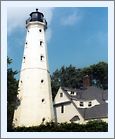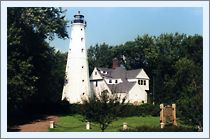 |
 |
 |
| Click thumbnails to view enlarged images | ||
| North Point Lighthouse | Seeing The Light |
|
|
|
|
Historical
Information
With the transfer of responsibility for the nation’s aids to navigation to the nine-man Lighthouse Board in 1852, the new Board was motivated to undo as many of the Pleasonton Administrations mistakes as possible. With Milwaukee’s growing importance as a shipping point, the Board made the replacement of the poorly located Milwaukee lighthouse one of its first priorities. Concurring with Homan’s prior observations, the Board determined that the best location for the light would be atop the bluff at the north point of the bay three miles to the north of the river mouth, where the elevated location would provide it with a commanding view of the entire bay. After receiving a Congressional appropriation of $5,000 for relocating the light on August 31, 1852, a site at the edge of the bluff between two deep ravines was selected in 1853, and the process of obtaining clear title to the reservation was initiated..
Burke only served for five years until he was removed from the position on April 10, 1861. William Bruin was appointed to succeed Burke, and tended the light for ten years until March 15, 1871, when he too was removed from the position. Two keepers were appointed and subsequently removed over the next six months until D. K. Green took over as Keeper on September 23, 1871. Two years after his appointment, Green’ s daughter Mrs. Georgia Stebbins, was diagnosed as having consumption. As she was living alone in New York City after the death of her husband, and her life expectancy was short, her physician suggested that she should move to Milwaukee to live with her father. Heeding her physician’s suggestion, Georgia arrived at North Point in 1874, only to find that her father was also in ill health, and she immediately assisting him with his light keeping duties. Evidently, the fresh lake air agreed with Georgia, as she took over all station duties as her father’s health deteriorated. No longer able to perform his duties as Keeper, Green was removed from his position at the opening of the 1881 Navigation Season. Aware of the fact that Georgia had been unofficially tending the light for seven years, Eleventh District Inspector Commander Joseph N. Miller appointed Georgia to the position of Acting Keeper of the North Point Light on April 2, 1881, and after a short three month probationary period she was promoted to full Keeper status on July 22. By this time, erosion of the bluff had advanced to the point that there was concern that if something was not done quickly to slow the process, the foundation of the tower itself would be undermined. Determining that there was no effective way to stem the erosion, Eleventh District Engineer Captain Charles E. L. B. Davis recommended that a complete replacement of the station at the western end of the reservation was the only economically viable solution. Supporting Davis’ recommendation, the Lighthouse Board recommended an appropriation of $15,000 be made to purchase the necessary land and build a new station in its 1885 annual report to Congress.
As work on the park neared completion in 1897, the Lighthouse Board undertook a number of changes at the station to better befit its new surroundings. The dwelling was substantially remodeled and the oil house moved closer to the tower so as to be less visible from the boulevard which passed across the bridges. The station grounds were landscaped and re-sodded, 560 feet of cast iron fencing installed adjacent to the lion bridge, and a concrete walkway laid from the front gate to the porch of the dwelling. However, not all of the changes undertaken were of a purely cosmetic nature, as a boiler was installed in the cellar of the dwelling to provide central heating, an enhancement which was almost certainly welcomed by Mrs. Stebbins.
Reaction in the maritime community to the closure of the North Point Light was both immediate and universally negative. Insisting that the light served the vital interest of mariners entering Milwaukee from the North, Milwaukee’s commercial and maritime interests began applying every possible pressure to convince Judson and the Board to reactivate the light. However, with the Board’s purse strings controlled by the Congressional appropriation system, Judson claimed it was impossible to reactivate the light without Congressional authorization and funding. With the likelihood of fast Congressional response remote, the Milwaukee Chamber of Commerce and the Milwaukee Merchants and Manufacturers Associations banded together to work out an arrangement whereby the two organizations would cover the costs of manning and operating the station until the Board could obtain the necessary Congressional funding. Thus, the light was reactivated as a private aid to navigation, and the Board immediately requested an appropriation of $10,000 to elevate the North Point tower above the tree line, and officially reactivate the station. Congress responded with the requested appropriation on March 4, 1909. and bids for the work were advertised soon thereafter. However, with the lowest bid for furnishing the steel work coming in at $6,398, Judson felt it would be impossible to complete the work within the $10,000 appropriation, and so turned his attention to the possibility of moving the station to a treeless area 3,000 feet to the northeast of the existing reservation. With no progress on construction, mariners turned to the Lake Carriers Association for assistance. After review by its Aids to Navigation committee, the Association drafted a resolution which was sent to both the Officers of the Ninth District and to the Lighthouse Board, in which it stated "It is of the greatest importance that the lighthouse on Milwaukee North Point be rebuilt and raised 35 feet, as projected. It is understood, an appropriation has been made, and that the work should be completed at the earliest date possible, but that if the district officers of the Lighthouse Department feel in their judgment that the best results will be obtained by building a new lighthouse about three thousand feet northeasterly from the present structure, that will be satisfactory; provided, however, that the present tower be not removed nor the present light be discontinued until the new lighthouse is completed and the light in operation."
The plan for elevating the light called for lifting the existing tower onto a new 30-foot tall base. Built of steel, the base was designed to be of the same octagonal plan and taper as the lower end of the existing tower, so that when stacked together the new lower section would appear as a natural extension of the upper. To further match the two sections, the new base was to be outfitted with cast iron windows exactly duplicating those in the existing tower. Bids for the ironwork and construction labor were again advertised in the spring of 1912, and contracts awarded soon thereafter. After delivery of materials at the site, reconstruction began on July 12, 1912 with the erection of a temporary frame tower 25 feet from the existing tower, to which the lens was moved on September 25. The old tower was completely disassembled, and a new concrete foundation 21 feet 6 inches in diameter poured concentric to the old foundation. Atop this foundation the new steel base was erected, and the old tower reassembled at its upper level.
The North Point light was electrified in 1929, and with the only light-related duties being the polishing of the lens brass and glass, Johnson’s duties became more akin to those of a groundskeeper and caretaker than light keeper. With the transfer of responsibility for the nation’s aids to navigation transferred to the Coast Guard in 1939, the old civilian keepers were given the choice of maintaining their civilian status, or transferring into the Coast Guard. Johnson elected not to transfer into the Coast Guard, and continued to serve as keeper of the North Point Light with a number of Coast Guard seamen rotating in as his assistants until the light was automated in 1943. The station continued to serve as housing for Coast guardsmen and their families for a number of years, until RADAR and LORAN eliminated the need for the station, and the venerable Fourth Order lens was removed from the lantern on March 15, 1994, and the station permanently closed. A neighborhood preservation group, North Point Lighthouse Friends was formed in 2002 with plans to restore the site. The group was awarded a $984,000 Federal grant in 2002, and estimates the total costs of restoration to around $1,500,000. The project’s start date will depend on when the Federal funding becomes available, in either July 2003 or July 2004. Restoration plans not only include the tower and dwelling, but will also a complete re-grading of the lighthouse grounds to seamlessly integrate the station property into historic Lake Park.
Keepers of this Light Click Here to see a complete listing of all Milawaukee North Point Light keepers compiled by Phyllis L. Tag of Great Lakes Lighthouse Research. Seeing this Light In Lake Park, located near the East end of North Avenue, North on Wahl Avenue. North Point Lighthouse Friends, a 501(c)3 non profit organization was formed in 2002 with their charter being the restoration of the historic lighthouse, and plan on opening the structure to the public in 2005. Visit their website at www.northpointlighthouse.org for information on the group's progress. Reference Sources Annual reports of the Fifth Auditor of the Treasury, 1838 - 1852 Annual reports of the Lighthouse Board, various, 1856 – 1909 Annual reports of the Commissioner of Lighthouses, 1910 - 1929 Annual reports of the Lake Carrier's Association, various, 1906 – 1934 Great Lakes Light Lists, various, 1861 – 1953 Lighthouse Luminaries on the Great Lakes, Inland Seas, Vol. 42, Fall 1986 HABS HAER survey of the site conducted in 1987 The Northern Lights, Charles K Hyde, 1986 Personal observation at North Point, 09/08/2000. Milwaukee Journal Sentinel, 2/10/99, 10/13/02 Keeper listings for this light appear courtesy of Great Lakes Lighthouse Research |